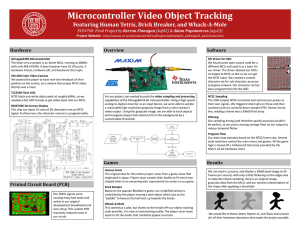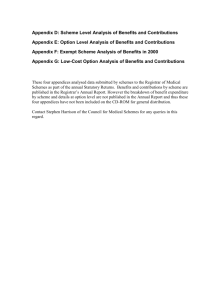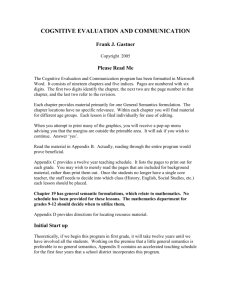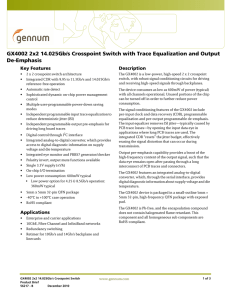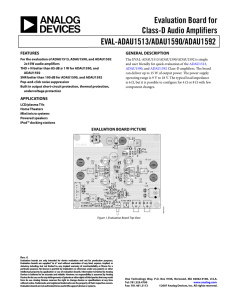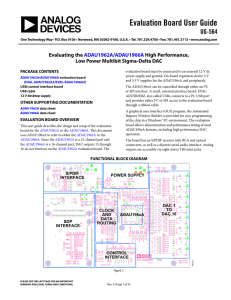Georgia Institute of Technology
advertisement
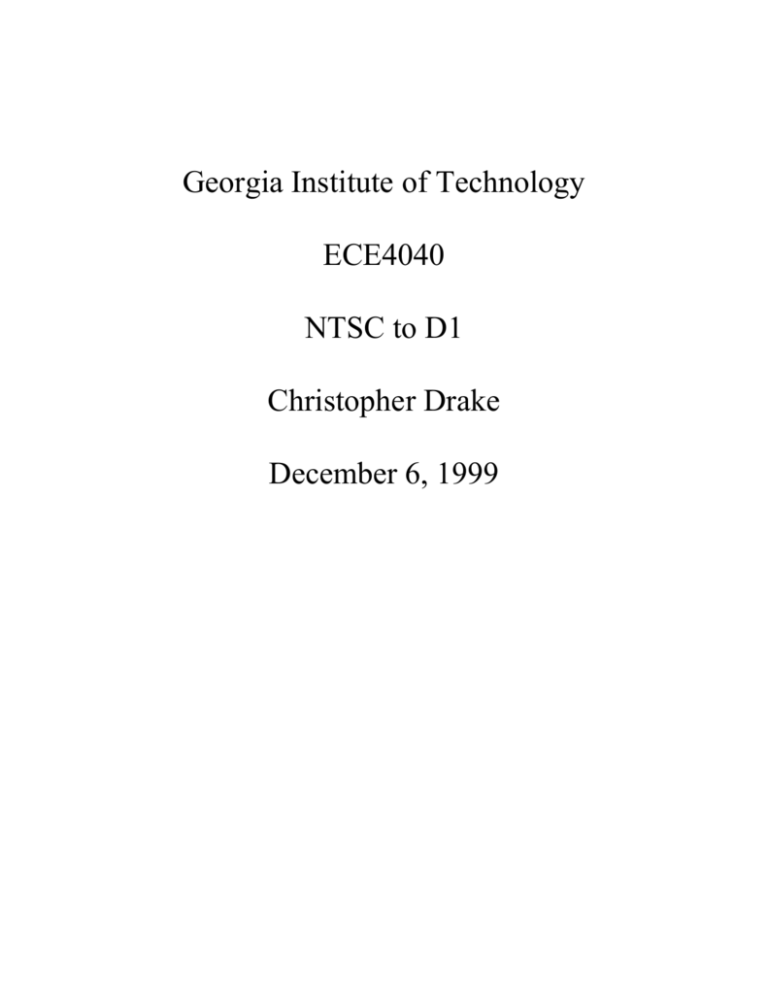
Georgia Institute of Technology ECE4040 NTSC to D1 Christopher Drake December 6, 1999 SUMMARY: The following report will focus on the design of the NTSC to D1 video conversion circuit. After the conversion is complete, the video signal will be transmitted via an optical or RF link at a rate of 270Mbs. To accomplish this goal, several different venders were used to achieve the desired conversion. By using the Samsung KS0127, the NTSC video is converted to RGB. The Gennum 9001 and 9022 will convert the RGB input to the D1 format. This circuit will be used in a video teleconferencing setting, where high quality video reproduction is desired. The cost of this project is approximately one hundred dollars and could be used in many other applications The following report describes the design of a NTSC to D1 video converter. The converter was built for the Wide band RF/OE Video Link Project. This circuit will take the NTSC video output of a CCD camera and convert it to the 270Mbs digital format. After the video is converted to the digital format, it will be coded and transmitted either by an optical or RF link. The design of the circuit can be divided into these parts: video conversion standard, digital interface standard, conversion of NTSC to D1, encoding and serialization, and ECL to TTL conversion. To begin, an explanation of video terms and standards should be addressed. 1) During the rest of this report digital video will be referred to as D1. D1 is the digitized version of NTSC and is used in applications such digital television. 2) NTSC is an acronym for “ Never Twice the Same Color” which describes a color modulation scheme. This is an example of composite video. 3) RGB stands for RED, Green and Blue. This is an example of component video. 4) YCbCR is defined in SMPTE CCIR 601 Standard and is now used for all digital formats. Y is the Luma, the black and white part of the video, while CbCr is the color difference. 5) 4:2:2 states that for every 2 “Y” samples there is one sample each of Cb and Cr. 6) Composite: A video signal that contains brightness, color and timing. 7) Component video is made up of three color components like YcbCr or RGB. These definitions were taken from the following web site”www.videodemystified.com”. Next, an explanation of the standards involved in the definition and transmission of digital video. The Society of Motion Picture and Television Engineers, from now on referred to as SMPTE, is an organization designed to define video standards for the United States. These documents cannot be viewed on the web and hence must be purchased. SMPTE standard ITU-R BT.601-5, see appendix 1, defines what a D1 video signal is. The following are just some of the parameters defined: termination and cable type, waveform characteristics, bit rate, measurement methods and timing of waveform components. SMPTE standard 125M, see appendix 2, was used to define the type of cable needed to interconnect the boards that will convert NTSC to D1. This standard defined parameters such as maximum length of cable, signal convention, termination and physical characteristics. A standard printer cable will meet the requirements of this standard. The next step is to define the circuit elements that will convert NTSC to D1. The first attempt was to find a chip set that would directly convert NTSC to D1. This wasn’t as easy as it sounds due to the requirements of the project, mainly that a chip was wanted not an entire circuit board assembly that had to controlled by an external computer. The Phillips SAA8110G, see appendix 3, falls into this category. Another factor was cost. The Faroudja FLI200 would perform the necessary conversion yet cost approximately two thousand dollars. Finally ANALOG DEVICES had a chip set (ADV7185), yet the chips aren’t going to be released until January 2000. After hours of web searching an alternative was almost reached. The Gennum Corporation builds a chip set, see appendix 4, that had RGB inputs. The chip set included the GF9105, GS9001 encoder and the GS9022 serializer, see appendix 4, 5, 6 respectively. To convert NTSC to D1, the GF9105 was removed and replaced with the Samsung KSO127, see appendix 7, which accepted serial NTSC and outputs parallel D1 video into the GS9001. The KSO127 “converts analog NTSC... into composite, S-video, or component format to digitized component video. Output data can be selected for CCIR 601 or square pixel rates in either YcbCr or RGB formats”(See appendix 7). The KSO127 has many applications yet will start up the mode needed without any external stimulus. The KS0127 has six inputs yet only the first is needed; yet all inputs were connected on board. Finally, the output of the Gennum 9001 was feed into the Gennum GS9022, see appendix 6. The GS9002 takes the parallel output of the GS9001 and encodes it into a serial output. The Gennum representative was able to send two evaluation boards that contained the GS9001 and an upgrade to the GS9022 serializer, the GS9032, see appendix 8and 9. The “GS9001 implements error detection and handling functions according to SMPTE RP165. Interfacing to the parallel port of the GS9022 serial digital encoder...the GS9001 provides EDH insertion and extraction for 4fc NTSC ...and 4:2:2 component standards up to 18 MHZ luminance sampling. The GS9001 also generates timing signals such as horizontal sync, vertical blanking, field ID and ancillary data identification”(Appendix 5). Another hurdle to overcome was that the output of the KSO127 output was TTL and the Gennum inputs to the GS9001 were ECL. The Motorola MCH100H600, see appendix 10, achieved this conversion. The interconnection of the parts had to be considered since the KS0127 has eight outputs and the input to the GS9001 has ten. Bumping the eight outputs up by two bits on the GS9001 input easily solved this. Appendix 11 contains the schematic of the entire circuit. Appendix 12 contains the board layout traces, pads and via holes necessary to construct a circuit board. Table 1 contains a list of parts necessary to construct the circuit. DESCRIPTION QUANITY COST VENDER CHIP 27 .18 EACH CUT DIGI-KEY PART # PCC1870CT-ND CAPACITOR TAPE 100 .1uF PCC1940CT-ND CHIP 3 CAPACITOR .94 EACH CUT DIGI-KEY TAPE 100 10uF PCC1943CT-ND CHIP 3 CAPACITOR .12 EACH CUT DIGI-KEY TAPE 100 22Pf M2093-ND WIDE BAND 3 $4.11 DIGI-KEY 10 FOR $2.70 DIGI-KEY CHOKES P75VTR-ND RESISTORS 6 P8054SCT-ND MOMENTARY 1 DIGI-KEY PUSH BUTTON SWITCH SE2638CT-ND 24.576MHZ 1 $1.56 DIGI-KEY AE1011 CABLE 2 $8.58 ea. DIGI-KEY 1635004 POWER 3 .53ea MOUSER 6 $1.92 MOUSER 2 4.58 DIGI-KEY 1 $18.00 SAMSUNG 1 SAMPLE GENNUM CONNECTION JACK 177-3138 BNC CONNECTOR A1025-ND D SUB FEMALE KSO127 VIDEO DECODER GS9001 CO PROCESSOR GS9022 SERIALIZER 1 SAMPLE GENNUM MC100H600 9BIT TTL-ECL 1 SAMPLR MOTOROLA 60 APPROX.$81.94 TOTALS Contact Information: 1) Digi-Key 1-800-344-4539 2) Mouser 1-800-346-6837 3) Samsung www.samsungsemi.com. Call All American @770-441-7500 ask for TK Contact Information Continued: 4) Gennum – www.gennum.com Video products. 5) MOTOROLA-www.motorola.com Finally a word about the Easy Trax board design. The Chris1.pcb file contains the board design for the KS0127, and the MC100H600. The file also contains the wiring for the Dsub female connector, which will connect this board to the Gennum 9001 evaluation board. Since the two chips and the connector had well over one fifty connections, a two- sided design was used. The use of VIA holes allowed the trace to move from one side of the board to the other so that traces didn’t overlap. Every care was take to ensure that all connections are correct, yet before turning in to get the board cut the connections should be reviewed. The schematic is illustrated in Figure 1, which was hand drawn and turned in separately. The second cable is for the connection between the GS9001 board and the GS9032 evaluation board. The GS9032 is an upgraded version of the GS9022. As with any engineering design, there are a lot of people behind the scenes that make all of this possible and I would like to take this time to acknowledge their assistance in the completion of this project. Dr. Martin Brooke: Having the patience to explain things to me and resolving design issues. Lawrence Carastro: Part allocation and guidance. John Fode: SMPTE resources John Myc: Gennum Corporation EB boards and chips design advice. My classmates who helped with finding parts and learning EASY TRAX in two days. Robert Riggsby Robert Barrington Micheal Kleppinger
